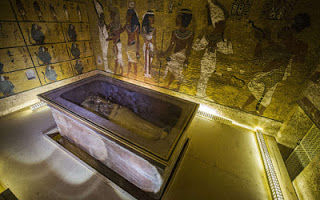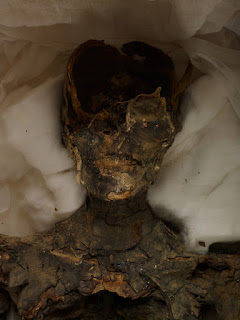Egypt

In a very flawed article from the Archaeology News Network, the former head of Egypt's Supreme Council of Antiquities, Dr. Zahi Hawass disputes Egyptologist Nicholas Reeves theory that the tomb of Nefertiti will be found behind the painted walls of Tutankhamun's tomb, in particular the north and west walls. Part of Dr.Hawass's concern is for the preservation of the paintings which would have to be removed.
The article suggests that behind one wall there will be found a 'mundane' storeroom. Hard to imagine anything 'mundane' about the discovery of a storeroom off the boy king's burial chamber. Cutting apart the paintings is certainly something that will not happen in the near future. With scans of the walls done the next decision may be drilling a small hole in each wall that a camera could look into any void found.
What started me writing this piece however was a number of inaccuracies in the article which include that King Ay was Tutankhamun's brother. Ay was an old man, and likely the power behind Tutankhamun's short reign. Ay succeeded Tutankhamun on the throne, and may, or may not have been Tutankhamun's ancestor, through the boy king's queen, Ankhesenamun, the daughter of Nefertiti.
The article moves further along with Dr. Hawass's belief that Nefertiti was likely one of two mummies found in the Valley of the Queens tomb 21. This is in error as the two female mummies in question were found in the Valley of the Kings tomb Kv 21. The mummy known as Kv 21 A, has through DNA found to likely be Tutankhamun's queen, through the fetuses found with Tutankhamun in his tomb.
The suggestion by Dr. Hawass that the torn apart remains of the mummy Kv 21 B is Nefertiti is about as awful as it gets. Mr. Reeves believes Nefertiti is intact while Dr. Hawass is suggesting of Nefertiti that she is represented by a mummy reduced to a sad pile of violated bones in the 19Th century. If DNA has proven that the mummy of Ankhesenamun, Kv 21 A, is the daughter of the Kv 21 B mummy, than it is certainly the worst possible ending to the search for Nefertiti.
 Notes:
Notes:
Photo of Tutankhamun's burial chamber, AFP
Photo of Kv21 B, Kenneth Garrett Photography
- Hawass On Kv64, Pyramids And Other Hopes For 2011
You Tube Thanks to Kate Phizackerley's News from the Valley of the Kings blog for this link. Rossella Lorenzi (Discovery News) interviews Zahi Hawass about excavation work being carried out at the moment and his hopes for 2011. The sound quality is...
- King Tut's Father Id'd In Stone Inscription
Discovery Channel (Rossella Lorenzi) An inscribed limestone block might have solved one of history's greatest mysteries -- who fathered the boy pharaoh King Tut. "We can now say that Tutankhamun was the child of Akhenaten," Zahi Hawass, chief of Egypt's...
- More Re Dna Testing To Be Carried Out On Fetuses
National Geographic (Andrew Bossone) The young Tut, who reigned from 1336 to 1337 B.C., is controversially thought to be the son of Pharaoh Akhenaten and his wife Kiya. But some archaeologists believe he could be the son of Akhenaten's other wife,...
- Neferetiti's Eyes
Archaeology Magazine - Nefertiti's Eyes (Earl R. Ertmman) Archaeology has a feature in the March/April 2008 issue entitled Nefertiti's Eyes, which you can see online at the above address. Did the queen's distinctive feature become a symbol...
- The Daughters Of Nefertiti
Valley of the Kings tomb KV63 was discovered quite by accident in 2005 by a team directed by Dr. Otto Schaden working on the tomb of Amenmesse inside and around the entrance of that king's tomb, KV10. As debris was being removed from in front of...
Egypt
The Truth in the Search for Nefertiti

In a very flawed article from the Archaeology News Network, the former head of Egypt's Supreme Council of Antiquities, Dr. Zahi Hawass disputes Egyptologist Nicholas Reeves theory that the tomb of Nefertiti will be found behind the painted walls of Tutankhamun's tomb, in particular the north and west walls. Part of Dr.Hawass's concern is for the preservation of the paintings which would have to be removed.
The article suggests that behind one wall there will be found a 'mundane' storeroom. Hard to imagine anything 'mundane' about the discovery of a storeroom off the boy king's burial chamber. Cutting apart the paintings is certainly something that will not happen in the near future. With scans of the walls done the next decision may be drilling a small hole in each wall that a camera could look into any void found.
What started me writing this piece however was a number of inaccuracies in the article which include that King Ay was Tutankhamun's brother. Ay was an old man, and likely the power behind Tutankhamun's short reign. Ay succeeded Tutankhamun on the throne, and may, or may not have been Tutankhamun's ancestor, through the boy king's queen, Ankhesenamun, the daughter of Nefertiti.
The article moves further along with Dr. Hawass's belief that Nefertiti was likely one of two mummies found in the Valley of the Queens tomb 21. This is in error as the two female mummies in question were found in the Valley of the Kings tomb Kv 21. The mummy known as Kv 21 A, has through DNA found to likely be Tutankhamun's queen, through the fetuses found with Tutankhamun in his tomb.
The suggestion by Dr. Hawass that the torn apart remains of the mummy Kv 21 B is Nefertiti is about as awful as it gets. Mr. Reeves believes Nefertiti is intact while Dr. Hawass is suggesting of Nefertiti that she is represented by a mummy reduced to a sad pile of violated bones in the 19Th century. If DNA has proven that the mummy of Ankhesenamun, Kv 21 A, is the daughter of the Kv 21 B mummy, than it is certainly the worst possible ending to the search for Nefertiti.

Photo of Tutankhamun's burial chamber, AFP
Photo of Kv21 B, Kenneth Garrett Photography
- Hawass On Kv64, Pyramids And Other Hopes For 2011
You Tube Thanks to Kate Phizackerley's News from the Valley of the Kings blog for this link. Rossella Lorenzi (Discovery News) interviews Zahi Hawass about excavation work being carried out at the moment and his hopes for 2011. The sound quality is...
- King Tut's Father Id'd In Stone Inscription
Discovery Channel (Rossella Lorenzi) An inscribed limestone block might have solved one of history's greatest mysteries -- who fathered the boy pharaoh King Tut. "We can now say that Tutankhamun was the child of Akhenaten," Zahi Hawass, chief of Egypt's...
- More Re Dna Testing To Be Carried Out On Fetuses
National Geographic (Andrew Bossone) The young Tut, who reigned from 1336 to 1337 B.C., is controversially thought to be the son of Pharaoh Akhenaten and his wife Kiya. But some archaeologists believe he could be the son of Akhenaten's other wife,...
- Neferetiti's Eyes
Archaeology Magazine - Nefertiti's Eyes (Earl R. Ertmman) Archaeology has a feature in the March/April 2008 issue entitled Nefertiti's Eyes, which you can see online at the above address. Did the queen's distinctive feature become a symbol...
- The Daughters Of Nefertiti
Valley of the Kings tomb KV63 was discovered quite by accident in 2005 by a team directed by Dr. Otto Schaden working on the tomb of Amenmesse inside and around the entrance of that king's tomb, KV10. As debris was being removed from in front of...
